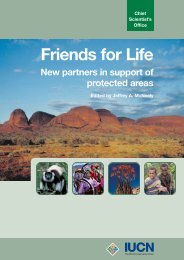Exchange programmes - IUCN
Exchange programmes - IUCN
Exchange programmes - IUCN
Create successful ePaper yourself
Turn your PDF publications into a flip-book with our unique Google optimized e-Paper software.
Implementation of an <strong>Exchange</strong> Programme for Protected Areas in East Asia<br />
� To develop participants’ skills and confidence in workingin diverse teams within<br />
rural and semi-rural communities to address complex stewardship problems;<br />
� To encourage the practical implementation of the ideas and recommendations<br />
resultingfrom exchanges and case studies; and<br />
� To publicise the results of the programme so that experience and recommendations<br />
can be disseminated widely. (CEI, 2000)<br />
Benefits accrue in three distinct areas:<br />
� The process of proposingand preparingthe case study develops cooperation,<br />
infrastructure and capacity in the host location. Local organisers have to: identify<br />
and convene appropriate representation; agree issues to be addressed; encourage<br />
community participation; plan and share tasks; and fund and manage the logistics<br />
of the team’s visit.<br />
� The interaction between the team and those they meet, culminatingin the public<br />
presentation and the report, articulates and reappraises local concerns, validates<br />
and revitalises existinginitiatives, introduces new ideas and provokes fresh<br />
thinking.<br />
� Workingtogether, under pressure of time and in an unfamiliar context, team<br />
members gain: confidence in applying their own expertise; new understanding of<br />
the breadth and interrelation of responses required in addressingcountryside<br />
issues; new ideas; and new skills in teamworkingand collaboration. For many it is<br />
also a new and powerful experience to work outside their normal formal position<br />
of authority, to an agenda entirely set by local stakeholders and residents, and<br />
many report an increased emphasis on listeningand buildingconsensus as the<br />
most significant positive impact on their working style.<br />
How the programme works<br />
Structure<br />
The transatlantic exchange has managing bodies in the USA and the UK. Participation<br />
from other countries operates through one or other of these bodies. The Glynwood<br />
Center, a non-profit organisation in the USA concerned with training and advice for<br />
rural communities, is the focal point for the <strong>Exchange</strong> Programme in North America.<br />
The Center orchestrates regional support and funding for case studies in North America,<br />
selects the individual host locations, and provides guidance and some financial assistance.<br />
At the same time, it identifies and selects half the team members for case studies in<br />
both North America and the UK.<br />
In the UK there is a national steeringcommittee consistingof representatives of a<br />
group of funding bodies (national and regional agencies and other bodies statutorily or<br />
constitutionally concerned with the countryside, cultural heritage and the rural economy)<br />
and chaired by the Countryside Agency (successor to the Countryside<br />
Commission). This Steering Group sets policy and strategic guidelines and assures core<br />
fundingfor a contracted executingagent, currently CEI Associates Ltd. CEI identifies<br />
case study locations in the UK, guides their development and recruits the other half of<br />
the team members. Thus while there are differences in structure dictated by the respective<br />
national contexts, the key operational axis lies in the close cooperation between<br />
CEI and the Glynwood Center.<br />
24






